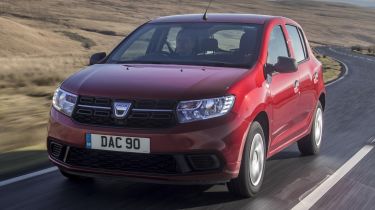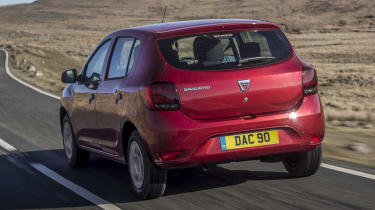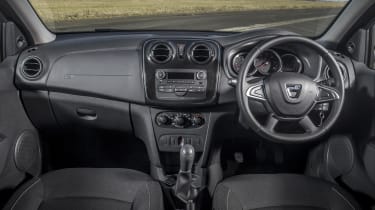Dacia Sandero 1.0-litre SCe 75 Ambiance review
You know an entry-level Dacia Sandero is going to be cheap but is it also good? Let's find out...

The Sandero is still a better buy with the punchy and frugal turbo motor, but don’t overlook the base 1.0-litre if you’re after an honest and practial small car on a tiny budget. Around town it offers reasonable performance and efficiency, while its cheaper insurance will be a boon for young buyers. The £1,000 saving is tempting, too, although the popularity of PCP deals brings far more accomplished small cars within easier reach.
We had our first taste of the updated UK-spec Dacia Sandero back in February, but that car featured Dacia’s turbocharged 0.9-litre three-cylinder petrol engine. In keeping with the Romanian carmaker’s value-for-money mantra, we’re trying the new entry-level engine for the first time to see whether it’s a saving too far.
Choosing your Sandero with the SCe engine choice saves you £1,000 (a sizeable 13 per cent) over the turbo TCe. For that, you get a larger 1.0-litre engine, but despite the bigger capacity, power drops from 90bhp to 73bhp. While that might not sound like a great deal, it’s the torque figure that really shows up the new unit: 140Nm for the TCe plays a modest 97Nm for the car we have here.
Used - available now

2019 Dacia
Sandero
20,183 milesManualPetrol1.0L
Cash £7,263
2022 Dacia
Sandero
21,884 milesManualPetrol1.0L
Cash £8,000
2022 Dacia
Sandero
11,601 milesManualPetrol1.0L
Cash £10,287
2024 Dacia
Sandero
6,701 milesManualPetrol1.0L
Cash £9,100Unsurprisingly, acceleration takes a hit, with the SCe taking over three seconds longer than the TCe over the benchmark 0-62mph sprint. It won’t crack 100mph, either, and feels considerably less sprightly in-gear, forcing you to work harder to keep pace with traffic. As a result it’s actually less economical on the combined cycle, only managing 54.3mpg where the turbo manages 57.6mpg.
But it’s not all bad news. In fact, the naturally aspirated petrol is more likeable than you may expect. Throttle response is sharper than the laggy TCe, making it smoother and easier to drive once up to speed. You’ll need to work the notchy gearbox and keep the revs up to make progress, but performance is perfectly adequate for town use, and on a par with many smaller (and pricier) city cars. It even sounds quite tuneful.
Our main gripe is with refinement – at idle and low speeds the three-cylinder unit sends more vibrations through the controls than most rivals, showing up the Sandero’s list price just as much as the cheap, hard cabin plastics. Thankfully, once you’re out on the open road it’s more subdued, mainly because wind noise and tyre roar are so pronounced.
The 1.0-litre engine is no lighter, so it’s no surprise that the Sandero feels dynamically identical. The ride is surprisingly comfortable, absorbing the worst of town potholes, but the handling is soft and remote, with pronounced body lean, limited grip and steering that’s heavy around town yet vague in the bends. The Sandero’s city car rivals are nicer to drive and feel more substantial, though none offer as much metal for your money.
Our Ambiance spec car is the one to go, though. The headline £5,995 pricetag of the no-frills Access model is tempting, but the £1,000 extra the Ambiance commands adds in essential kit such as air-con, electric front windows and even a DAB radio with Bluetooth. That makes it the real bargain in the range.









